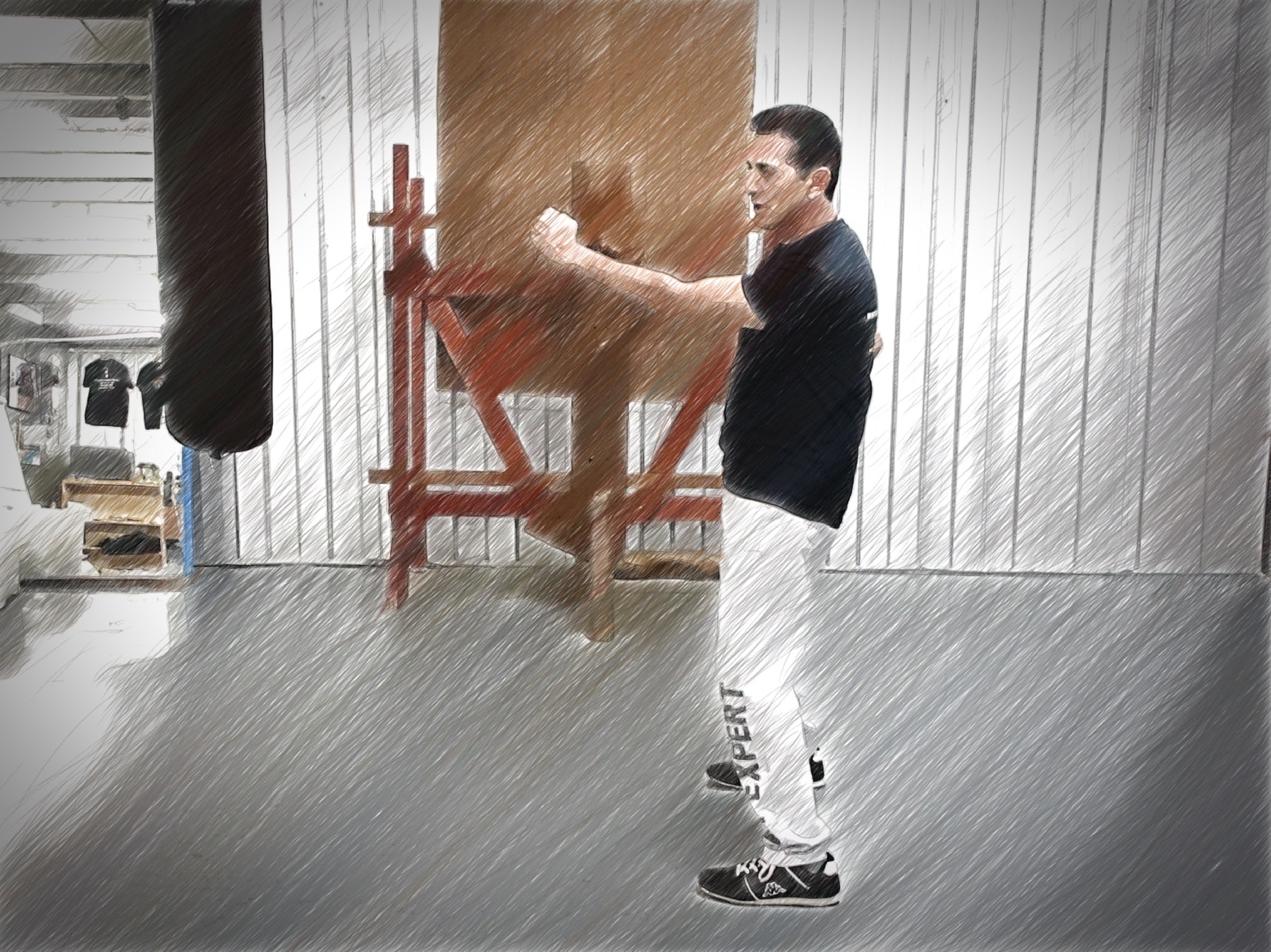The punch should always be executed from the centerline with the small knuckle aiming towards the opponent’s nose or face. The elbows should drive the hand, not the shoulders, and the punch should ‘swing’ from the hip. These points are very important.
When your hands are open or outside the centerline and the opponent launches a punch to your centerline, you should intercept by punching to the point where your fist would end up if it were a centerline punch, but without bringing your hand to your centerline first. To do otherwise would be a waste of time. This should be considered carefully.
As you continue to improve your Siu Nim Tau you must also practice the straight punches outside of the form. “It is a must to practice the straight punches daily,” says Sifu Loukas. He insists that students should average around 2,000 punches a day in order to develop the coordination of both hands, accuracy, speed, and flow. Most importantly, this practice trains the hands to strike automatically whenever an opening becomes available.
The next step is to start practicing hitting the wall bag. This helps strengthen the knuckles and gets the hands used to hitting objects. Without practicing hitting the wall bag your Wing Chun punch will not be good in combat.
Also, you must pay attention to differences between hitting a wall bag and punching in the air. When practicing punching in the air, the punches should be fast, using both hands simultaneously. One hand should pull back just a little while the other one is punching as straight as possible. However, when hitting the wall bag the punches are vertical and they should not be practiced fast. The first exercise is to improve speed. The second is to train for power and toughen up the knuckles.
The chain Straight Punches
The energy comes from the elbows through the forearms exploding into the fist. It is very important that your fist must be in a straight line with your arm, otherwise you can damage the wrist. It is like a piston with the energy going from the elbow into the hands. When striking, do so with the knuckles—with the first point of impact being the small knuckle of the pinky finger followed by the other two large knuckles. To ensure the target is on the centerline take an imaginary straight line from the nose to the knuckles of the fist to avoid the effect of parallax shift.

The optical illusion of Wing Chun
You see the leading hand, but actually in Wing Chun we are hitting with the rear hand—which is already charged and loaded. The first hand, which has been extended, is pulling back; the rear hand is actually striking. Think of pulling back with the lead hand while simultaneously pushing out with the rear hand. The concept is to land multiple strikes against the same target. The idea should be of a small gun firing rapidly rather than a large gun firing a massive shot with delay in between each shot. Strikes should be rapid, simultaneous, continuous, and directed to a small target.
Imagine a small target like a small circle with the punches landing in the center of that circle without pause. Then imagine a small dot in the middle of a small circle just big enough for your fist to fit through. (For example, the invisible compass point from which a circle is drawn.)
Use the Small Knuckles
Why do we hit with the small knuckle instead of the big knuckles? The reason is that the small knuckle is like a knife point penetrating internally into the target with the remaining large knuckles following. The Wing Chun strike is therefore an internal strike, not just an external strike. Imagine an iron ball striking and hitting the surface with the impact extending into the inside of the body.
In this type of punching knocking out the opponent from the leading hand is unlikely, just as in boxing it is highly unlikely that an opponent can be knocked out from the jab.
The Wing Chun rear hand can be seen as the cross but without using the shoulder. Instead, the shoulder needs to be tucked in to allow the whole body to follow the hands as one unit. So don’t think of knocking out the opponent with the lead hand—if you do manage this think of yourself as lucky! It’s the use of the whole body to transmit force into the small point of the striking surface (the small knuckle) and the target surface (the small circle area of the opponent). Think of force=mass times acceleration (f=ma). Which is why Wong Shun Leung used to call Wing Chun a scientific fighting system making use of body mechanics.
Think of punching at the speed of light. However, to practice this you must begin by practicing with stillness. This must be done deliberately in order to learn how to go through the centerline. Eventually you’ll practice together with the footwork.
Another important point here is that the elbows, as they return back, must “sink” in order to be loaded for the next punch. They must sink just enough to be locked but not sink all the way back. When you pull back it’s like you pull something to you. This pulling force drives the opposite pushing force of the striking (rear) hand. In other words, you pull the lead hand by sinking the elbow toward your hip to generate the opposite energy of the rear hand striking out. Think of an old-fashioned gun—it needs to reload with the lead hand coming back in order for the rear hand to strike out.
When you’re punching, think about your elbows sinking while watching your wrists and keeping your eyes on the target to ensure that your fist goes through the target out of the other side. Think of “multiple simultaneous activities.” Finally, it is worth pointing out that in many styles of martial arts, practice is based on circular motion. Wing Chun practice, however, is based on a “forward circular exchange.” Receive and attack; be the last to strike. Or as Sifu Loukas often says: “Be late to be on time.” You must research this well.
The above is an excerpt from Wing Chun In-Depth: Skills for Combat, Strategies for Life by Munawar Ali Karim and Loukas Kastrounis, publish date May 2023, YMAA Publication Center, ISBN: 9781594399275



